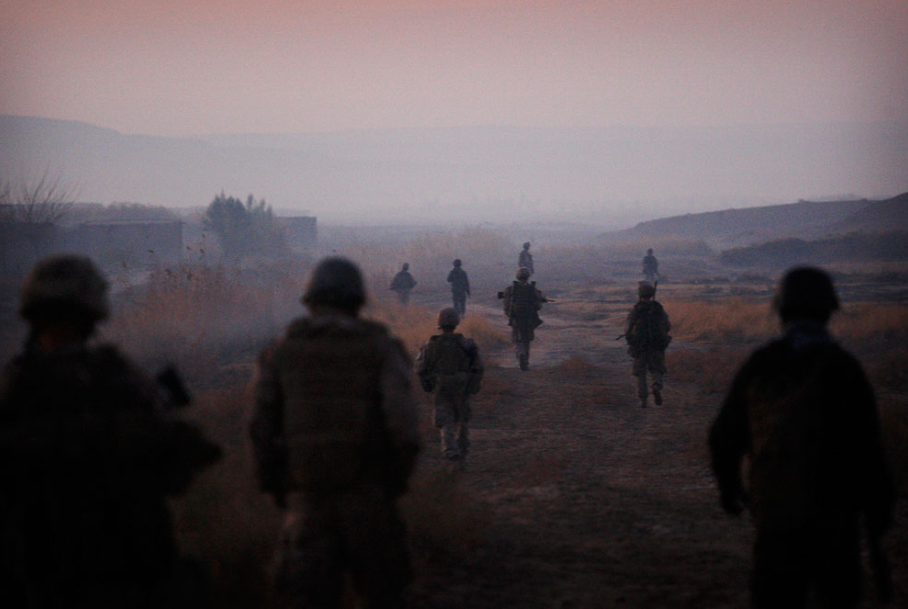The current war in Afghanistan began in October, 2001. In U.S. history only the Revolutionary War and the War in Vietnam have occupied longer periods of time. For most of us this has been a quintessentially modern war fought at a distance: we have “lived through” the war, but not “in it.”* Temporally present, the war remains geographically distant, and as time has passed we have become increasingly inured to both, habituated to the war’s everydayness—an ordinariness made manifest by the capacity of realist photography to construct us, here at home, thousands of miles from the violence and suffering, as passive and objective spectators. Recently, however, realist photography has given way to an artistic impressionism that seeks to open the war to a different affect.
Notice how the caption in the NYT features the conventional expectations of professional journalism, reporting exactly what we are seeing in all of its mundanity, while telling us almost nothing at all, the meaningful significance of the image elided by the abstract invocation of time and distance: “US Marines and Afghan National Army soldiers carried out an operation in the Garmair District of Helmand Province in southern Afghanistan on Wednesday.” And, of course, it is the representation of time and distance that animates this image. Were this an ordinary photograph of a patrol shot in middle distance, adhering to the realist conventions for focus and exposure, it is likely that we would not take a second glance at it. We would see it, but we would not look at it.
But, of course, it is not an ordinary image. Shot from a long view (almost, but not quite a panorama), mindful of the effects of linear perspective, and cast in muted, hazy light, the focus dreamy-soft to the point of distraction, the photograph has all of the qualities of an impressionistic water color. And as it animates an impressionist aesthetic, notice that it complicates the relationship between the scene and the viewer. One can no longer look at the representation as an objective, mechanically reproduced image that provides all that one needs to know. It is impossible to distinguish between US Marines and Afghan Nationals, time is elongated into an abstract and almost imperceptible future, and in the process, what is palpably distant becomes ever closer as the viewer is now encouraged (or dared) to look over the edge of the frame with a certain degree of awe and foreboding (perhaps invoking something like the sublime affect of Casper David Friedrich’s Wanderer Above the Sea of Fog).
War tests the limits of human communication: it cannot be experienced in its totality, and thus it can never known—let alone communicated in any complete way—by one individual to another; it mobilizes appeals for solidarity while separating people from home and community; and so on. And all of this is made more problematic as we become habituated to these inherent dilemmas, made all the more “comfortable” with a war at a distance that we see but never really comprehend. Photographs like the one above aestheticize war, to be sure, but in doing so they make it increasingly difficult to look and not see, to experience the distance between here and there at a distance.
Photo Credit: Kevin Frayer/AP
*This quotation, as well as the inspiration for the post come from Mary Favret’s very important War at a Distance: Romanticism and the Making of Modern Warfare (Princeton UP, 2010).

Photography as a process is highly objective, unlike a hand made image. What is in front of the camera/lens will be recorded, whether the shutter speed is long or short, subject movement blur/camera shake do not alter this fact, and neither do they reduce the objectivity of the process. Photography is different to hand made images in that, when the shutter is fired, the image is generated by a mechanical/optical&now electronic process that is not affected by the human thought process. If a green apple is photographed, the camera will record a green apple. If a human was painting a green apple and hallucinated that the apple was in fact red, he might then draw a red apple whereas the apple was in fact green. The objectivity principle breaks down when an image is produced using mental thought process. The human mind is more inclined to pass a photograph as truth because the brain knows of the objectivity principles that generate a photographic image. There is special warrant for the brain to pass a photograph as true at the first order of perception rather than pass it on to be critiqued at the second and third orders, which is what would happen with a handmade image. Regards.
[…] http://www.nocaptionneeded.com/2010/01/war-at-a-distance/ […]
“Highly objective” but, alas, not ultimately objective! And there is the rub.